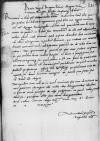List #2147
Bona Sforza do Ioannes DANTISCUSCracow (Kraków), 1539-05-03
| odebrano [1539]-05-25 Rękopiśmienne podstawy źródłowe:
Pomocnicze podstawy źródłowe:
| ||||||||||
Tekst + aparat krytyczny + komentarzZwykły tekstTekst + komentarzTekst + aparat krytyczny
R paper damaged⌈[R]R paper damaged⌉everendissimo in Christo Patri,
Reverendissime in Christo pater sincere nobis dilecte.
Habuimus cf.
Nos equidem iuri nostro et in tuendo nominato suo non de text damaged⌈[e]e text damaged⌉erimus et non patiemur alienigeno illi nobis illis derogationibus illudere, in qua re
Bene valeat S(trenuitas) or S(inceritas)⌈S(trenuitas)S(trenuitas) or S(inceritas)⌉ Tua.
Dat(ae) or Dat(um)⌈Dat(ae)Dat(ae) or Dat(um)⌉
Ad mandatum proprium serenissime


 BCz, 3465, p. 282
BCz, 3465, p. 282